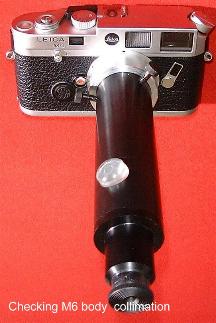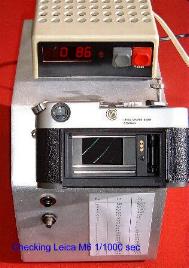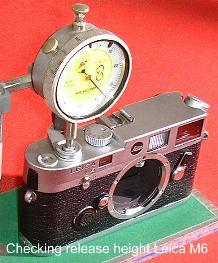Camera Repairs & Restoration - Luton - EnglandVery few camera repair workshops ever check the body collimation of the camera they are repairing mainly because they do not have access to a body collimator . For example the Leica R4 has a body depth (flange to focal film plane) distance of 47.00 mm +/- 0.01mm (one hundreth of a millimeter tolerance) . This can be checked with a dial gauge but it will only give the reading taken at the centre of the film plane . With the correct collimator it is possible to check if the lens flange is parallel to the film plane over the entire format . This is essential if corner to corner sharpness is to be obtained from the lens onto the exposed film . It is also possible to tell when a camera body has been dropped or knocked . Shimming out the flange will rectify the collimation . Your repair shop may have a collimator to set lenses at infinity but setting the flange to focal plane distance cannot be done without a dial gauge and a body collimator .
|
 Checking the body collimation on a Leica M6
Checking the body collimation on a Leica M6
Testing the curtain travel and high shutter speeds is best done using a strobe . The device gives important information that is not possible to obtain with conventional shutter speed testers. These may measure the shutter speed at different positions , but the Leitz strobe shows acceleration of both blinds , dynamically , and any deviations can be easily determined , shutter bounce and other brake related faults show up immediatley . The diagonal pattern produced by the equipment gives more information than just , overall shutter speed . We always use the correct equipment when servicing Leica cameras . Check that your repairer can test body collimation and adjust your camera using the necessary equipment. Otherwise he's just guessing ! |
 The 'DRUM' strobe , showing parallel pattern at 1/1000 sec.
The 'DRUM' strobe , showing parallel pattern at 1/1000 sec.
The Leica R4 is a complex camera and it is impossible to repair and service this camera without a digital storage oscilloscope . Some books have been written by a 'Master Camera Technician ' proposing that you can just take a Leica R4 apart and do repairs without any knowledge of what is actually going on with the electronics in the camera. Just removing three screws will upset the memory storage and this will make the camera unreliable , with the auto shutter hanging open when it should fire through at 1/250 sec. The digital scope is used to adjust the switching of all aspects of the camera. The short term memory switch should operate for exactly 1.5 ms , any longer or shorter and faults appear . The iris diaphragm should close to its minimum aperture within 95 ms
|
 Setting the memory switching on the Leica R4 / 5 camera
Setting the memory switching on the Leica R4 / 5 camera
It is important that the the exact point where the shutter releases , on a Leica M6 , is set correctly. This is what photographers like about the M6 (& all M cameras) , because they know that an exact moment in time can be captured without any delay , unlike many modern auto-focus and digital cameras , that have a delay between pressing the release and the shutter actually firing. There is also another reason why this precise point should be set and that is because faults can occur if it is not exact. The Leica R series also requires that the release depth for the separate events that occur during an exposure are exactly set . REPAIR PRICE GUIDE
Setting the body depth and body collimation
|